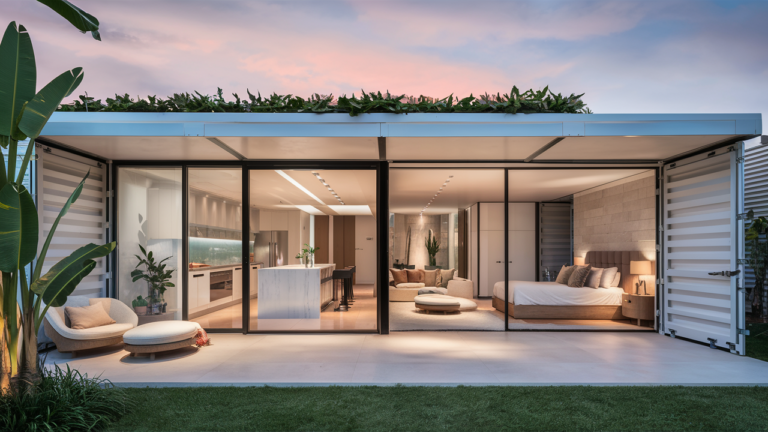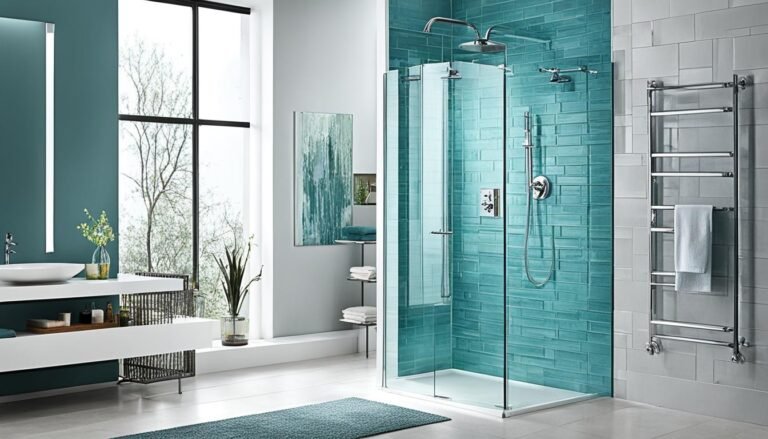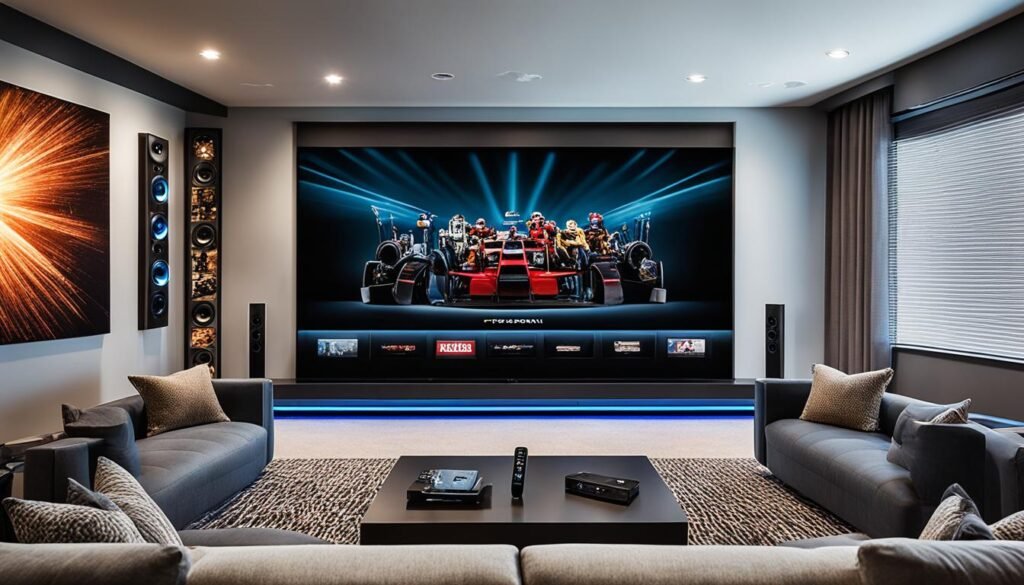
Stylish Home Theater Design Ideas for a Cinematic Experience
Ever thought about taking a room in your home and making it into a magical movie theater? You can turn your living room, den, extra bedroom or basement into a stunning theater room pretty easily. With the right media room design and home cinema ideas, it’s totally doable.
No matter the size of your space, adding special design touches and quality furniture can make it feel just like a real cinema. For example, you might want to look into sectional sofas fitted with USB ports, which range from $2500 to $5000. Or how about DIY fiber optic kits for false ceilings with stars, ranging from $500 to $1500? There are so many choices, you can pick what works best for your home.
Spending on soundproofing, which costs around $1000 to $3000, can make your sound system sound even better. Adding LED lights that give off a warm glow, around 200 to 400 lumens, can make the space cozy and perfect for movie nights. A control system, like a smart remote or a home automation setup, will make managing your theater simple. Put your unique stamp on the design, and you’ll have your very own movie premiere spot.
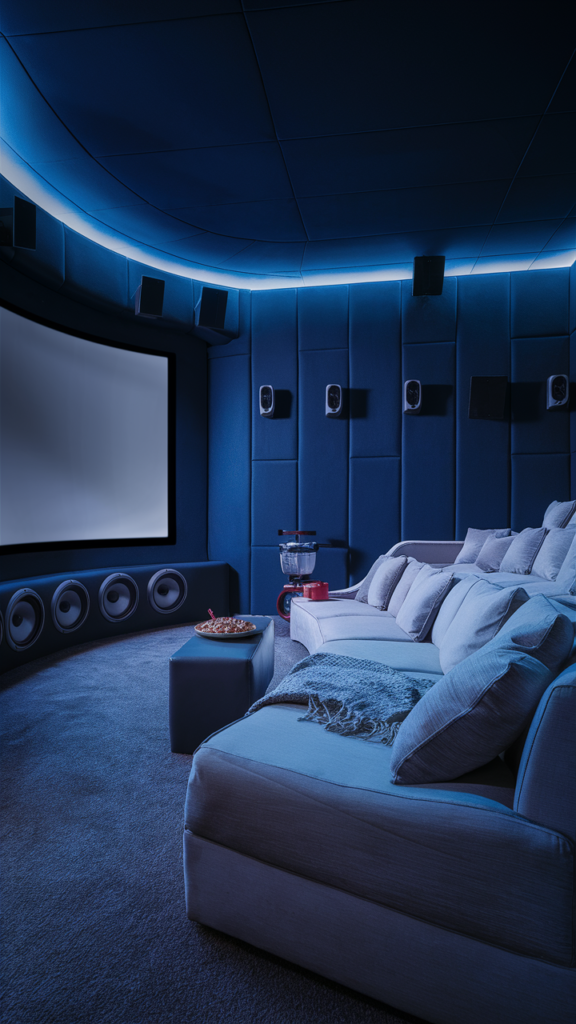
Choosing the Perfect Room for Your Home Theater
Starting an amazing home theater means picking the perfect room. This choice can make your viewing experience much better. A carefully designed home theater turns any space into a place for great fun.
Finding a Quiet Space
To have a great home theater, pick a quiet place. Spare bedrooms or closets can be turned into theaters if you don’t have a basement. Using drywall on the walls for soundproofing helps block outside noise.
Consider Basement Placement
Basements are great for home theaters. They’re usually dark and quiet, so the view is clear. Basements’ high ceilings are perfect for projectors and keep the heat away from viewers.
Basements make it easier to hide wires too. A good home theater room has few doors and windows, with enough space for seats. Putting seats on different levels can make your movie experience better.
Remember, if you pick a basement or another room, keep sounds in and out. This way, you won’t bother the neighbors when you watch movies.
Investing in Quality Visual Equipment
Choosing the best visual equipment for your dream home theater is key. You must decide between a top-notch projector or a large TV. The option you pick depends on if you want a fixed screen or the flexibility of a projector. Let’s compare the benefits of each for your home theater.
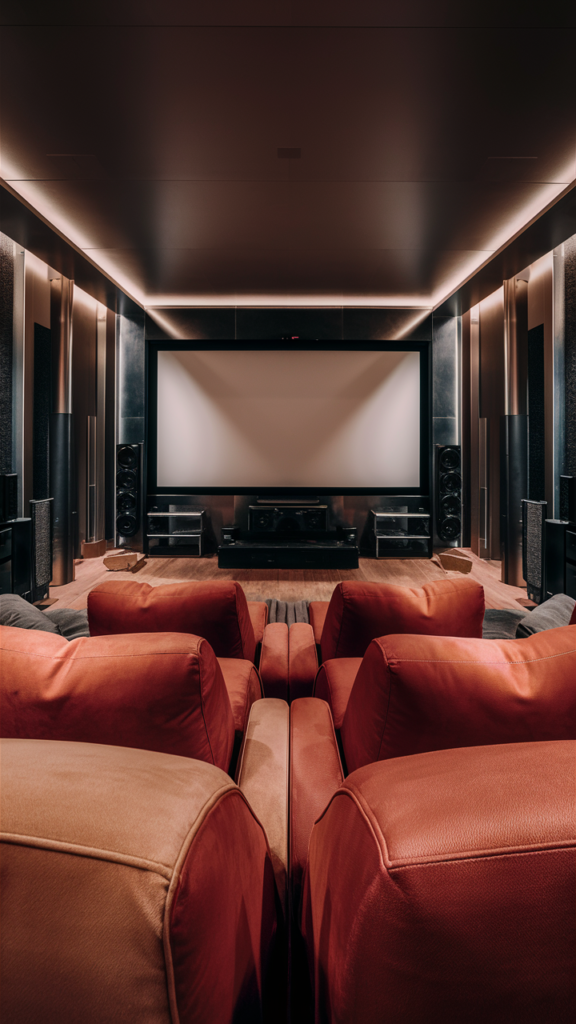
High-Quality Projectors vs. Large-Screen TVs
Projectors can show images as big as 150 inches. They are a budget-friendly choice, priced between $500 and $1,000. If you want convenience and consistent image quality, a large-screen TV might be better. It’s all about your personal needs and preferences.
Choosing the Right Screen Size
Getting the right screen size is important for a great viewing experience. It depends on your room’s size and how you place the seats. The ideal screen should be placed at a distance between 1.5 to 2.5 times its width. An angle of 30 to 40 degrees for viewing also helps. This setup creates a true movie theater feel in your home.

Utilizing Personalized Seating Solutions
To make a modern theater room perfect, you need to think about the seats. They should be comfy and easy to use when watching movies for a long time. Custom seats can turn your room into a warm place for watching films.
Comfortable Sectional Sofas
Sectional sofas are great for both hanging out with the family and enjoying movies with friends. They are handy and can come with USB ports and recliners. A good set might cost you between $2500 and $5000. They can be changed to fit your theater’s layout. Sectional sofas not only give more seats but make your room look good too.
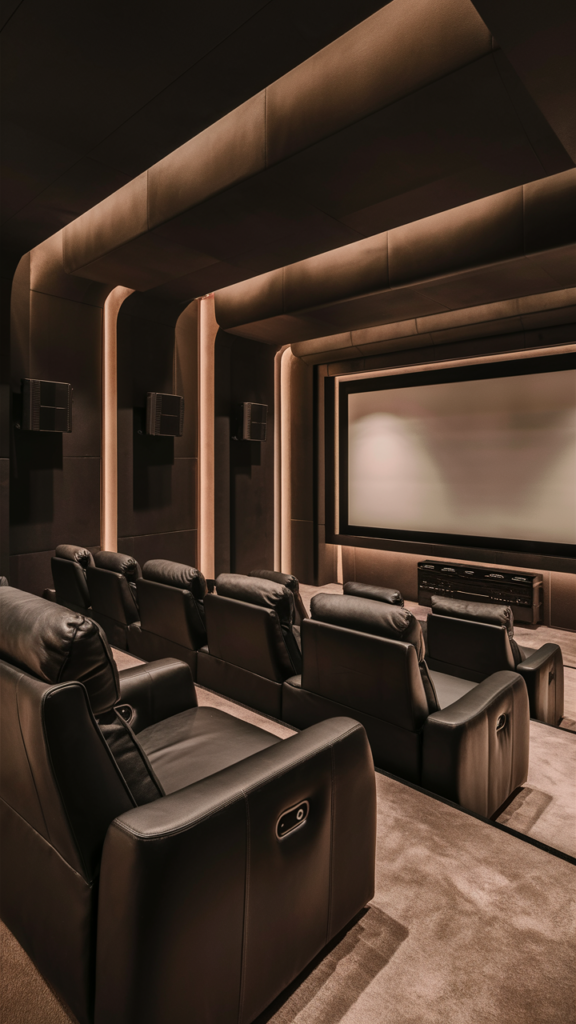
Reclining Theater Seating
For a real movie night feel, choose reclining seats for your theater. They offer each person their space with extra features like mini tables and speakers. You can get these seats for less than $1,800. Swivel chairs can also be added. They help everyone find the best spot for watching, whether it’s the big screen or TV.
Using furniture that has more than one use, such as ottomans with storage, can help. It keeps things neat and tidy. You can also pick inexpensive options like bean bags, cushions, or second-hand sofas to make the room welcoming without spending too much.
Home Theater Decor to Elevate the Experience
Decorating your home theater is more than arranging gadgets. Your decor choices are key to making a space that draws you in. By adding themes and movie posters, you make each night at the movies unique.
Thematic Decor Elements
Adding special elements can turn your movie-watching space into a unique haven. Think about using ruby red recliner chairs. They’re popular in many theaters for their comfort and vibrant style. You might also like to put in smart window panels, which can show different scenes and make the room seem bigger.
If you wish for a night sky feel, try fiber optic lights on your ceiling. They can be installed for a few hundred dollars and let you change their color and brightness. To make the room pitch dark, and help keep the sound inside, use blackout shades. They’re great for managing temperature and reducing noise.
Using Movie Posters
Movie posters add a special Hollywood touch to your home theater. They show off your love for movies too. You can make them stand out even more with frames that have LED lights. Painting the walls in dark colors like brown, gray, or black also helps keep the focus on your screen.
For a practical addition, consider a DIY snack bar made from pallet wood. It’s great for storing snacks and utensils. Plus, it adds to the overall theme of your home theater.
By using smart lights, speakers, and shades, you can make your theater even better. These smart devices improve how you use the space and save energy. The goal is to have a theater where every detail makes watching movies a great experience.
Incorporating Surround Sound Systems
To make your home cinema feel just like the movies, you need a top-notch surround sound system. This key piece boosts the sound, pulling you into the film like never before.
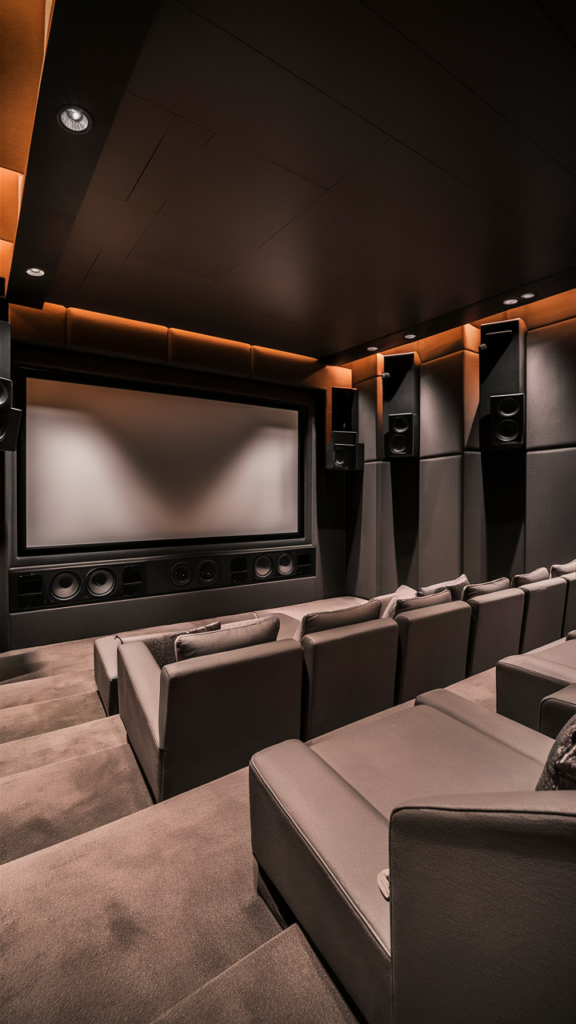
Placing Subwoofers Effectively
Subwoofers need the right spot to really thump. Putting them in corners or against walls helps spread that deep, rich bass around. Just avoid the room’s center to keep the bass even.
Positioning Surround Speakers
For sound that surrounds you, where you put your speakers matters a lot. Surround speakers should go to the sides and a bit behind you. They need to be at about ear level. This setup helps with the ‘you’re right there’ feeling.
Front speakers can go on walls or stands. Aim them a bit towards where you’ll be sitting. This makes the sound clear and direct. When you arrange everything just so, your home theatre will sound amazing. It’ll turn watching movies into something out of this world.
Effective Use of Lighting for Ambiance
Lighting is key in setting the right mood in your home theater. It’s vital for keeping the picture clear and making the viewing enjoyable. Using lights you can adjust or control smartly can turn your space into a true cinema.
Dimmable Lights
Dimmable lights hold the key to managing the light in your theater. Directional canned lights keep light down, preventing screen disruption. Seat-side lamps with dull shades also add light without affecting the picture.
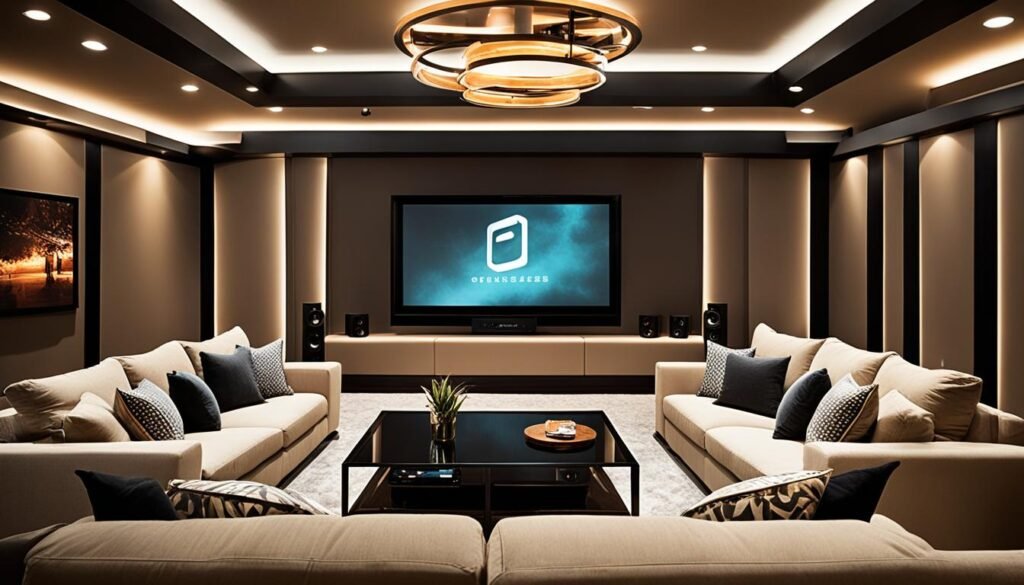
Smart Lighting Options
Smart lights bring a lot to home theaters. They’re easy to control with apps, and offer cool features like adjustable scenes and sensors. Plus, LED strips add a nice touch, using less energy and giving the room a stylish look.
Choosing the Right Color Palette
Choosing the right colors for your media room is key. It affects both how the room looks and works. The right colors make your home theater look great and more enjoyable.
Using Dark Colors
Dark colors work well in a home theater. Black is good for the area around the screen, creating a clear focus. Navy blue or charcoal gray can add fun while keeping things cozy. Make sure to use matte paint to kill reflections.
Brown shades make your space feel warm and inviting. Combine deep reds with gold for a touch of luxury. Use eggshell or matte finishes to keep the mood and avoid reflections.
Soft Palettes for Reducing Eye Strain
Softer colors are also great for home theaters. They help lessen eye strain. Choose hues that work with dark tones but don’t glare. Use matte paints to avoid too much reflection.
Knowing what colors do can help you design a better space. It makes your small home theater a welcoming place. A space where movies feel more special.
Soundproofing Your Home Theater
Creating a perfect movie environment in your home theater is all about soundproofing. This stops noises from outside and loud movie sounds from bothering others. It creates a peaceful atmosphere for your movie nights.

Materials for Soundproofing
You can choose from several materials to make your home theater sound better. Basic options can cost between $1000 and $3000. Advanced choices might be more than $3000. Some common materials are:
- Mass Loaded Vinyl: It’s a heavy material that stops sound well.
- Acoustic Panels: These absorb sound, decreasing echoes.
- Quietspace Acoustic Panels by Autex: They greatly reduce background noise reflections.
- Acoustic Insulation Batts: When put in walls, ceilings, and floors, they reduce sound transfer.
- Soundproofing Door Seals: They stop sound from leaking under doors.
Effective Room Setup Techniques
Setting up your home theater right is key for great sound. Here are some tips:
- Use flooring underlayments to cushion sound.
- Install ceiling soundproofing systems to keep sound inside the room.
- Choose solid-core doors over hollow doors to block sound better.
- Heavy curtains or drapes can help reduce outside noise.
By applying these tips, you can make your home theater a wonderful place. It will improve sound quality and make movies even more enjoyable.
Optimizing Home Theater Layout
Creating a home cinema is more than just picking a spot for the TV. The right layout can make your movies sound and look better. When setting up your space, think about the room size and shape. Aim to boost what you see and hear. The folks at Home Theater Academy suggest a room that is 24 feet by 15 feet, with a 9-foot ceiling, for the best experience. But, don’t worry, smaller areas can also be made into great home theaters.
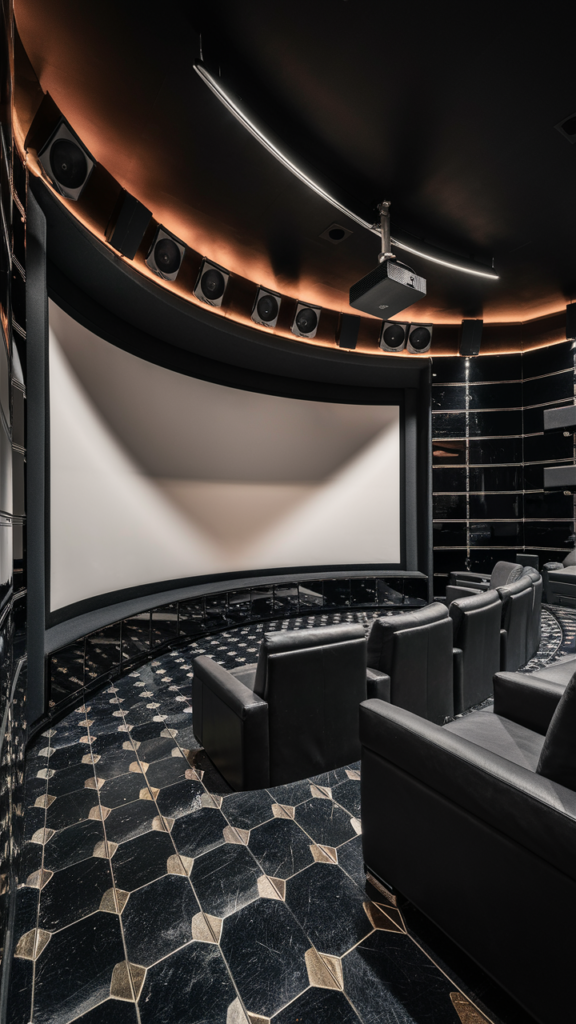
Choosing the Best Floor Plan
For the best sound and view, aim for rooms with certain dimensions. The height, width, and depth should follow a specific ratio. This often leads to a better sound environment. If your room is small, consider rows of seats to fit more people comfortably. When spacing out the seats, make sure there’s room for everyone to stretch their legs.
Reducing Noise Disturbances
Noise can really ruin the movie magic. Place your speakers and screen wisely to reduce outside sounds in your theater. Following the right distance from the screen is key for a comfy viewing spot. Adding sound panels and thick carpet helps with the sound quality too. If you have a standard 7-foot ceiling, it’s easier to set up your projector screen well.
Don’t forget to manage all those cables. Keeping them neat and hidden makes your theater look better. Also, surround sound and dim lighting can set the mood for a great movie night. With careful planning, your home theater can feel just like the movies, but better. It’s your private cinema right in your own home.

